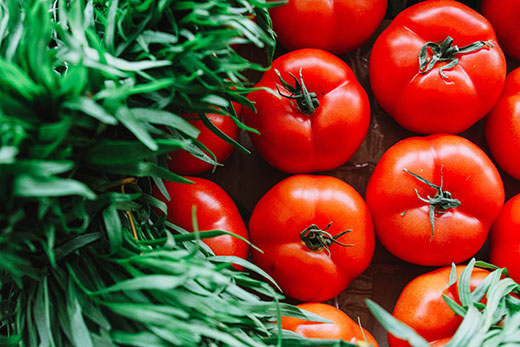
Home gardeners brag about bright red tomatoes. Hot temperatures may affect the color and prevent the fruit from ripening quickly.
Kansas heat may be slowing tomatoes from ripening
Pick during ‘breaker’ stage and store inside, says K-State horticulture expert
July 23, 2020
MANHATTAN, Kan. – Kansas gardeners may need just a little more patience and ingenuity if they’re finding that their tomatoes are slow to ripen this summer.
Kansas State University horticulture expert Ward Upham said recent heat may have caused the plants to go into “survival mode,” a time when it instead concentrates on moving water.
“The hot weather we have had recently not only interferes with the pollination of flowers, but it also affects how quickly fruit matures,” Upham said. “The best temperature range for tomato’s growth and development is 85 to 90 degrees Fahrenheit.”
Recently throughout the Midwest, temperatures topped 100 degrees, which causes fruit development to “slow to a crawl,” according to Upham.
“Tomato color can also be affected by heat,” he said. “When temperatures rise above 95 degrees, red pigments don’t form properly, though the orange and yellow pigments do. This results in orange fruit. It doesn’t affect the edibility of the tomato, but often gardeners want that deep red color back.”
To help tomatoes ripen to a bright red color, Upham said gardeners should pick them during the ‘breaker’ stage, or at that point when they are just starting to turn color.
“At this point,” he said, “the tomato has cut itself off from the vine and nothing will be gained by keeping it on the plant. If tomatoes are picked at this stage and brought into an air-conditioned house, they will ripen more quickly and develop a good, red color. A temperature of 75 to 85 degrees will work well.”
High heat also will cause poor fruit to set, especially on slicer tomatoes.
“Cherry tomatoes seem to be more heat tolerant,” Upham said. “But for slicers, high temperatures seem to interfere with pollen viability or can cause excessive style growth, leading to a lack of pollination. Tomatoes that have already formed (before excessive heat) are not affected.”
Upham said it takes about three weeks for tomato flowers to develop into fruit that is about the size of a golf ball. After that, growth is usually more rapid over the following three to six weeks, and then just a few more days to change color.
“Though there are ‘heat-set’ slicing tomato varieties that will set fruit at higher temperatures, that difference is normally only two to three degrees,” Upham said. “Once cooler temperatures arrive, tomato flowers will resume setting fruit.”
Upham and his colleagues in K-State’s Department of Horticulture and Natural Resources produce a weekly Horticulture Newsletter with tips for maintaining gardens and home landscapes. The newsletter is available to view online or can be delivered by email each week.
Interested persons can also send their garden- and yard-related questions to Upham at wupham@ksu.edu, or contact your local K-State Research and Extension office.
